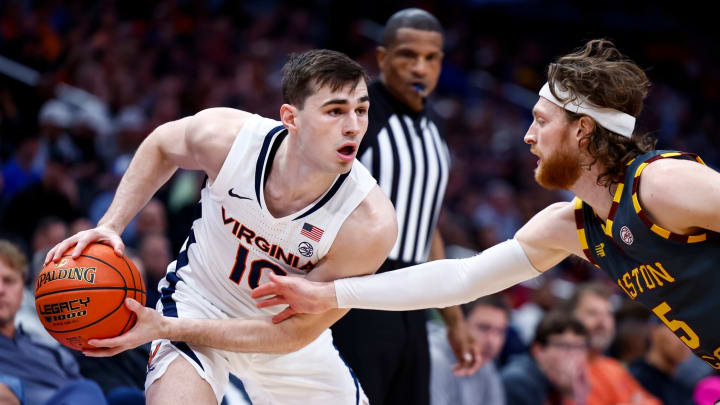Virginia Basketball Roster Analysis: Balancing Youth vs. Experience

Since Virginia captured the school’s first men’s basketball national championship in 2019, myriad changes have swept throughout the sport. COVID’s interruption of the 2019-20 season ultimately led to a one-year eligibility provision adopted by the NCAA, while landmark Name, Image, and Likeness legislation (NIL) has given players the right to profit from their standing as student-athletes. Thus, the offseasons looked a whole lot different pre-COVID and pre-NIL than they do now. Coach Tony Bennett’s rosters throughout the 2010s garnered four regular season titles, won 2 ACC Tournaments, and staved off the field to win it all in 2019, all accomplished before the pandemic struck.
Virginia men’s basketball’s offseason — initially tumultuous following a humiliating First Four exit to Colorado State — has nonetheless provided reason for optimism. With the roster finalized and summer practices well underway, Coach Tony Bennett will begin the season with six returning scholarship players (two — Anthony Robinson and Christian Bliss — who redshirted all of 2023-24) and seven newcomers. A retooled unit featuring eight underclassmen (including Carter Lang) will be chock-full of youth and inexperience, yet this shouldn’t necessarily forebode a disappointing year for the ‘Hoos.
The figures below measure the correlation between the percentage of scoring returned by eleven Virginia teams and their success — arbitrary yet noticeable when tracking the difference in record and seeds held in the NCAA Tournament.
Data Set: Virginia Basketball % Scoring Returned From Previous Year
1. 2022-23 (91.4%)
- Record: 25-8 (15-5 ACC)
- NCAAT Seed: 4
- Result: First-round exit to #13 Furman
2. 2015-16 (73.5%)
- Record: 29-8 (13-5 ACC)
- NCAAT Seed: 1
- Result: Elite Eight exit to #10 Syracuse
3. 2014-15 (70.7%)
- Record: 30-4 (16-2 ACC)
- NCAAT Seed: 2
- Result: Round of 32 exit to #7 Michigan State
4. 2018-19 (66.7%)
- Record: 35-3 (16-2 ACC)
- NCAAT Seed: 1
- Result: Won National Championship over #3 Texas Tech
5. 2020-21 (60.3%)
- Record: 18-7 (13-4 ACC)
- NCAAT Seed: 4
- Result: First-round exit to #13 Ohio
6. 2017-18 (52.1%)
- Record: 31-3 (17-1 ACC)
- NCAAT Seed: 1
- Result: First-round exit to #16 UMBC
7. 2016-17 (42.0%)
- Record: 23-11 (11-7 ACC)
- NCAAT Seed: 5
- Result: Round of 32 exit to #4 Florida
8. 2024-25 (36.9%)
- Record: ???
- NCAAT Seed: ???
- Result: ???
9. 2019-20 (32.4%)
- Record: 23-7 (15-5 ACC)
- NCAAT Seed: N/A
- Results: Tournament canceled, was a near-lock to qualify
10. 2023-24 (28.1%)
- Record: 23-11 (13-7 ACC)
- NCAAT Seed: 11
- Results: Play-in exit to #11 Colorado State
11. 2021-22 (24.9%)
- Record: 21-14 (12-8 ACC)
- NCAAT Seed: N/A
- Results: NIT quarterfinal exit to St. Bonaventure
A rough pattern emerges from the prior ten seasons. The six Virginia rosters which retained at least 50% of their scoring production held at least a four seed in the NCAA Tournament, with four of the six entering the Big Dance as a one or a two seed. The 2019-20 unit — having lost the big three of Kyle Guy, Ty Jerome, and De’Andre Hunter — bucked the trend somewhat by riding an eight-game win streak into the tournament, ultimately canceled due to COVID. Notably, the rosters lowest in scoring % returned suffered. The 2021-22 roster — having landed two rock-solid contributors in ECU’s Jayden Gardner and Indiana’s Armaan Franklin — nonetheless struggled to find its footing without many players who had previously played in Bennett’s system.
Last year’s roster cracked the field in the NCAA Tournament, yet graduate transfers could not sufficiently fill the holes left in Virginia’s crowded frontcourt. Ultimately, experience within Virginia’s system matters. The transfer portal has left many wondering whether the developmental approach that Coach Bennett has embraced has run its course; however, one ought to hope that it will experience a resurgence with this new class of sophomore transfers and redshirt freshmen. The 2024-25 unit — lodged in between the 2019-20 and 2016-17 squads — has no choice but to thrust newcomers into significant roles, a reality of the portal era.
The figures below account for total minutes played at the college level prior to the season in question. Understandably, five of the top seven in this list come from the post-COVID era, which gave an extra year of eligibility to players affected by 2019-20 postseason cancellations.
Data Set: Virginia Basketball Minutes Played Since 2014-15
- 2022-23 (17,487)*
- 2015-16 (13,348)
- 2023-24 (11,887)*
- 2020-21 (9,456)*
- 2014-15 (9,193)
- 2024-25 (8,868)*
- 2021-22 (8,485)*
- 2018-19 (8,208)
- 2017-18 (8,059)
- 2016-17 (7,961)
- 2019-20 (5,473)^
* = post-COVID years
^ = Tomas Woldetensae’s numbers are not available from JUCO
In contrast to the scoring percentage numbers, total minutes played at the college level holds far less weight when projecting a season. Interestingly, however, is the uptick in minutes played by rosters in the post-COVID era; with one extra year of eligibility granted by the NCAA, Virginia has witnessed six players finish their fifth season of college basketball in Charlottesville — Kihei Clark, Jayden Gardner, Armaan Franklin, Ben Vander Plas, Jacob Groves, and Jordan Minor. For only the second time in the post-COVID era, the Cavaliers will not have a fifth-year on the roster. The 2024-25 roster will begin the season fourth out of five COVID teams with respect to minutes previously played at the collegiate level. They are also 14th out of 17 ACC teams in the minutes played department, yet eighth in scoring percentage returned.
It would be wise to look at this roster in the context of the four prior post-COVID rosters. While third in scoring percentage returned and fourth in total minutes played, the 2024-25 unit more resembles the complexion of the 2021-22 squad — no fifth-years, several incoming transfers with multiple years of eligibility, and near-exact minutes played at the college level. The disappointing finish to that season should not cast a shadow over the promise of this new-look team, however. The seven Top-100 recruits assembled by Bennett is a high in his fifteen-year tenure, and Virginia’s scoring percentage returned is 12% higher than in the season which culminated in an NIT quarterfinal exit.
Plenty of questions remain, and youth is certainly in play. Despite the emphasis on plug-and-play portal additions in the current landscape, experience in Bennett’s system still holds weight.
More Virginia Men's Basketball News & Content
Virginia to Host Five-Star Top 10 Overall Recruit Nate Ament for Official Visit
Virginia Basketball: Projecting UVA's Starting Five for Next Season
Column: Why the Kyle Guy Hiring is Great for Virginia Basketball
Virginia Basketball Assistant Coach Johnny Carpenter Leaving the Program
Virginia Basketball: Evaluating the Strengths & Weaknesses of UVA's Roster
